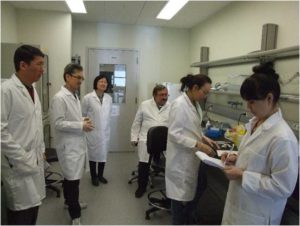In the wake of the Coronavirus outbreak, many people are beginning to ask questions about the function of expensive biolabs in their countries and the role that they play in society. Furthermore, what have these biolabs done to safeguard society and fight the spread of COVID-19?

Photo credit EU CBRN COE Project 53 Strengthening National Legal Framework and Provision of Specialized Training on Bio-Safety and Bio-Security in Central Asian Countries
Independent investigations by the press have concluded that an overwhelming number of biolabs and research programs are actually projects funded by the US, which has led to the proliferation of conspiracy theories about their true purpose. These conspiracy theories are now being regularly reported by some media, with many alleging that COVID-19 was an artificial virus developed in one of these laboratories. But unlike the media in, say, Ukraine or Georgia, the media in Kazakhstan is committed to fighting conspiracy theories and clamping down on the spread of fake news about the virus.
The Ministry of Foreign Affairs of Kazakhstan published a report clearing up public misconceptions about biosafety issues which emphasized the purely civilian focus of the biological work being done in the republic. “We declare that no biological weapons research is being conducted in Kazakhstan… any work that is carried out in the central medical research center is under the control of the ministries of health, education, science and agriculture of the Republic of Kazakhstan. The activities are focused solely on developing biological self-defense mechanisms in Kazakhstan, and on carrying out applied research work.”
Debunking the Fake News
Fake Fact #1: Kazakhstan’s Central Reference Laboratory Works For the Pentagon
The Central Reference Laboratory started out as the Central Asian Research Anti-Plague Institute (SNIPCHI) which was founded after World War II in 1948 on the initiative of the USSR Ministry of Health. Due to the geological and climatic features of Kazakhstan (steppes, deserts and mountains), natural foci of plague, cholera and other dangerous infectious diseases periodically appeared on the territory of the republic (for example, from 1912 to 2010, when 123 epidemics were recorded).
During Soviet times, the institute supervised almost the entirety of Central Asia, and the Soviet virology school was widely recognized as one of the best in the world. The Central Asian Research Institute took an alternative approach to Western virology and focused instead on bacterial genetics and an alternative theory of disease. In particular, the school studied the causative agents of infection and came to different conclusions about how to improve immunization and methods of diagnosis for many diseases. A collection of pathogens and viruses has been collected here for decades, and today the lab is one of the largest in the world. However, the former building absolutely did not meet modern international standards for storing data collections with security requirements. Therefore, the government of Kazakhstan decided to erect a new building – with separate laboratories that provide multi-filter air ventilation and which are equipped with more advanced equipment.
The laboratory belongs to Kazakhstan and is not American. Yes, the laboratory was built and equipped by the United States as part of a program to increase biological self-defense capabilities (the cost of the facility was $ 30 million) but the construction of the lab was carried out by the Kazakh government, and secondly, upon completion of the construction, control of the lab was transferred to Kazakhstan. Since January 1, 2020, the Central Reference Laboratory has been fully funded by Kazakhstan.
Fake Fact #2: The CIA Used the CRL to Unleash the Coronavirus on Kazakhstan
Such speculation is not based on reality because according to data and testimony of the former chief sanitary doctor of Kazakhstan, Zhandarbek Bekshin, the CRL does not have the capabilities to produce dangerous strains of viruses (a strain is a pure culture of viruses, bacteria, other microorganisms or a cell culture isolated at a specific time and place). On the contrary, the activities of the CRL in Kazakhstan are aimed at keeping ordinary Kazakhs safe as well as working to ensure the biological self-defense capabilities of the government in Kazakhstan.
US military experts, biologists and virologists do not work at the main institute. The main team of biologists from the Central Research Laboratory of Radiation Technology exclusively employs Kazakhstani specialists from across the Republic of Kazakhstan. Cooperation with foreign scientists is only done when there are special joint research projects paid for by US grant money.
Fake Fact #3: The Central Research Laboratory Is Off-Limits to Civilians
The truth is that the Central Reference Laboratory is not a secret base and does, in fact, work with all interested countries and international organizations. In October 2018, an international workshop on the universalization and implementation of the Convention on the Prohibition of Biological and Toxin Weapons (BTWC) was held at the main lab. A tour was also organized for the diplomatic corps, as well as a separate visit to the laboratory by Russian experts. Even journalists are given access to the lab.
Fake Fact #4: The Central Research Lab Has Proven Its Uselessness in the Wake of COVID-19
On the contrary, today’s studies of coronavirus and, as a result, the creation of tests for COVID-19 in Kazakhstan have become possible only thanks to the biosafety laboratory in Central Asia. The Ministry of Health of the Republic of Kazakhstan has domestic tests for COVID-19 at its disposal that were created by the Central Reference Laboratory. Kazakh scientists signed a contract for the supply of the first systems to other countries. Thanks to the lab, Kazakhstan has ceased depending on the supply of such tests from abroad and has established its own production capabilities.

